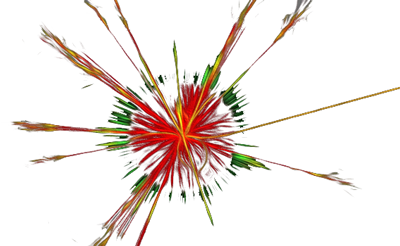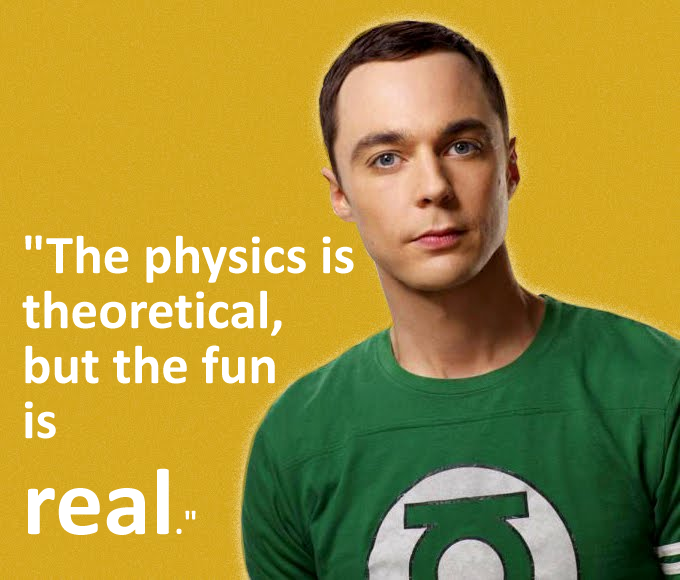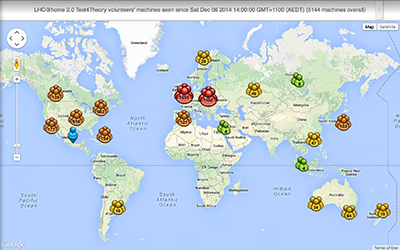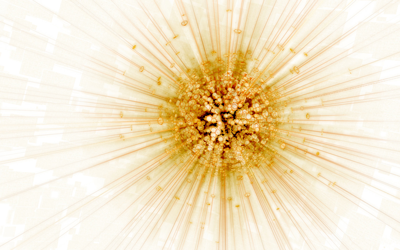
Particle Physics
|
|
Particle Physics - also called High Energy Physics - is the study of the ultimate building blocks of nature: the basic elements that make up our universe and the physical laws that govern them. Continuing from atomic and nuclear physics, modern particle physics reveals the quantum world of photons (waves in the electromagnetic field) and leptons (such as the electron and the elusive neutrinos), gluons (waves in the strong nuclear force field) and quarks (nuclei have quarks inside), and W, Z, and Higgs bosons (associated with the weak nuclear force). Those are the fundamental quantum fields, as far as we know. (Quantum fields generalize the notion of "particles" to incorporate both wave- and particle-like aspects of matter and forces, relativistic effects, and antimatter.) But not everything about them is well understood. Nor do we know if "that's all". In fact, mysteries abound, and are discussed in technical lingo under names like quark confinement, dark matter and dark energy, the matter-antimatter asymmetry problem, electroweak symmetry breaking and the hierarchy problem, and early-universe inflation, to name but a few. Also, we can't hide from gravity forever. To find out more, we use some of the largest machines on Earth - particle accelerators. The challenge for theorists is to try to think thoughts - and do calculations - that match. |

What I do
|
|
Most of my work concerns "event generators": computer programs that simulate the collisions happening in accelerators like the Large Hadron Collider at CERN, near Geneva. Think of an event generator as a "Virtual Collider" - in your computer. By comparing simulated particle collisions ("theory") to real-world measurements ("experiment"), we test the theoretical models, whether they agree with nature - or not. Disagreements are always interesting: they indicate that there is something wrong with the model; something we haven't understood; something to learn. Within the context of the simulations, we can play with the physical laws: introduce new forces or new types of fundamental particles, or even change the number of space-time dimensions, to give but a few examples. Thus, we can gain insight into how new laws of nature would manifest themselves in experiments. This is not only interesting from a theoretical point of view, but has important practical applications. Our experimental colleagues use our simulations to plan and design the experiments, and to optimize their searches for "new physics". We can also modify the way we model or approximate the known laws of nature. Systematic variations of the modeling assumptions allow us to gauge the resiliency of the theoretical predictions, identifying areas where improvements are needed, and avoiding conclusions drawn on uncertain grounds. And we can explore new approaches to solving or modeling the underlying physical theory. This is where most of my work goes, trying to achieve as high a level of detail and accuracy as possible. My particular specialty is the strong nuclear force, describing the interactions of quarks and gluons, and encapsulated by a theory called quantum chromodynamics (QCD). Although the basic principles of QCD were formulated already in the 1970ies, it gives rise to spectacular emergent phenoma which are still only partly understood; such as "jets" (collimated sprays of radiation) and "strings" (not superstrings, just strings), the latter of which are capable of exerting a pull sufficient to lift a 16-ton truck, quite a "strong force" indeed when applied to a single elementary particle. The core of my research concerns jets, jet substructure, string fragmentation (the formation and breakup of QCD strings), and the general physics of proton-proton collisions. But since event generators are quite general-purpose things, I frequently deal with other forces and phenomena as well, both known and hypothetical. Indeed, the fact that this research spans a huge range of energies and phenomena is one of the aspects I find most enjoyable about it, as well as jets and strings really being quite beautiful things, once you get to know them.

I also try to get the public involved in high energy research, for instance via LHC@home, a volunteer computing project developed at CERN, online since 2010. Participants can download their own virtual colliders and run them on their home computers (eg at times when they would otherwise just be "sleeping"), contributing valuable computing power to theory calculations for the LHC. Incidentally, this was the first volunteer computing project in the world to use virtualization technology, an aspect developed specifically for this project. |

What I really do(in less fair English) |
|
Event generators can be used to generate high-energy-physics "events", i.e. sets of outgoing particles produced in the interactions between two incoming particles. The objective is to provide as accurate as possible a representation of event properties in a wide range of reactions, within and beyond the Standard Model of particle physics, with emphasis on those where strong interactions play a role, directly or indirectly, and therefore multihadronic final states are produced. The physics is then not understood well enough to give an exact description: instead the programs have to be based on a combination of analytical results and various QCD-based models. The calculations are based on quantum field theory, spanning both rigorous solutions and phenomenological models, and are cast as Markov Chains, solved using random-number Monte Carlo methods. The physics areas include hard subprocesses, initial- and final-state parton showers, underlying events and beam remnants, fragmentation and decays, and much more. The programming language of choice is currently C++, with predecessors in FORTRAN. The main event generator, PYTHIA, is a general-purpose vessel for exploring phenomena both within and beyond the Standard Model. It is one of the most widely used tools in high energy physics. Its hallmark feature is the "Lund string model", used to model "hadronization" (the process by which quarks and gluons turn into hadrons). Strings are a universal phenomen that appears in extremely diverse physical systems, from superconductors and superfluids to cosmic strings. The strings in QCD enforce "confinement" - their strong pull locking quarks and gluons away inside nucleons, unable to escape. (If this sounds slightly similar to what black holes do by way of gravity, then perhaps there are even things to be learned by comparing the physics of strings to that of black holes. That's one current research question I don't know the answer to. Yet.) Currently, we model QCD strings as simple 1+1-dimensional worldsheets with a tension of about 1 GeV/femtometre, and the string-breakup process by quantum tunneling.

The more specialized program VINCIA (a plug-in to PYTHIA) explores a new method for generating perturbative corrections to high-energy scattering processes, in particular those associated with "jets" in quantum chromodynamics (QCD). Jets have fractal patterns inside them, quantum structures of jets-within-jets and fluctuations-within-fluctuations. VINCIA works by first building up this semi-classical self-similar ("fractal") radiation pattern, taking the so-called "running coupling" into account (which generates departures from true scale invariance), and then imprinting non-fractal quantum corrections on top of it. The latter are calculated systematically order by order in perturbative quantum field theory, a task mainly handled by other computer programs today, rather than by hand.
|
